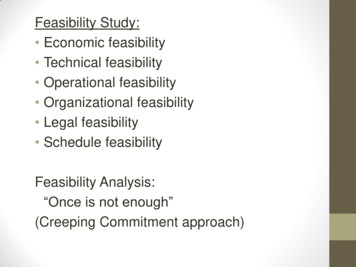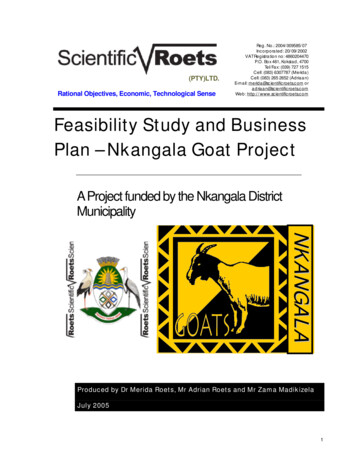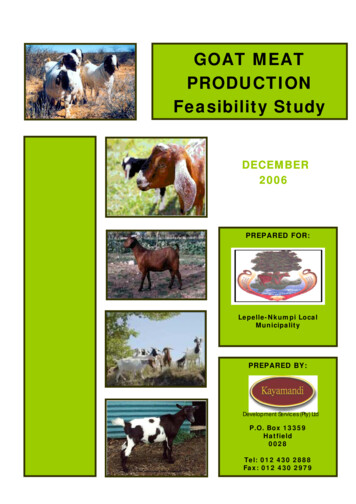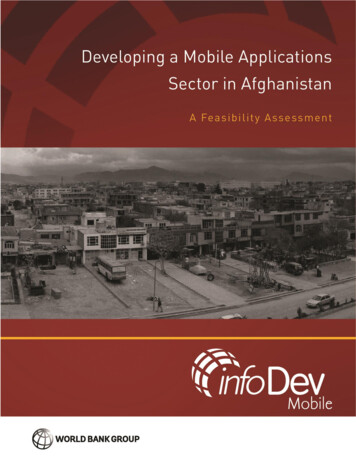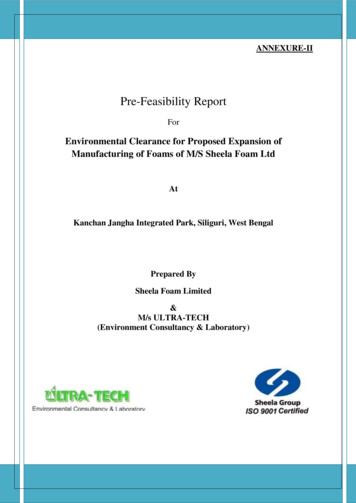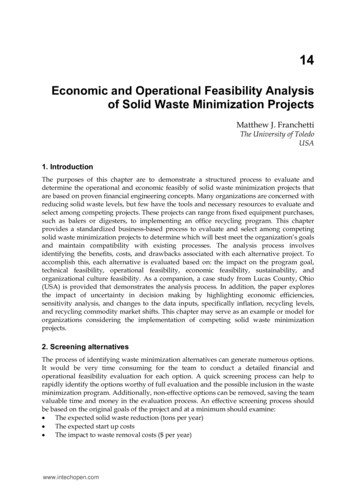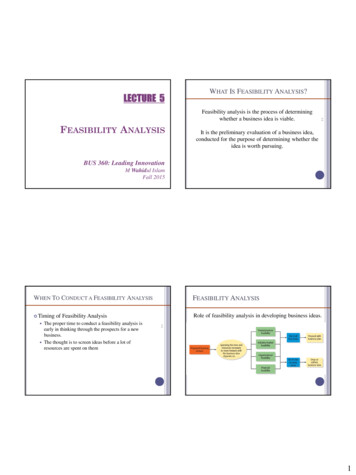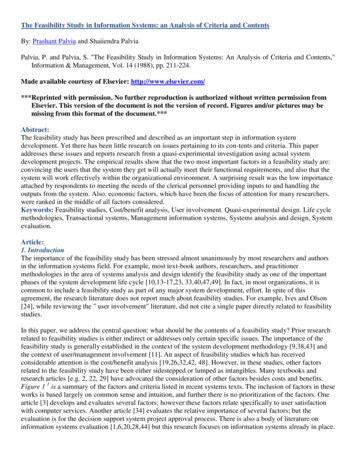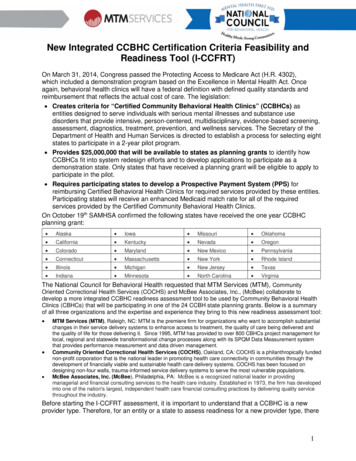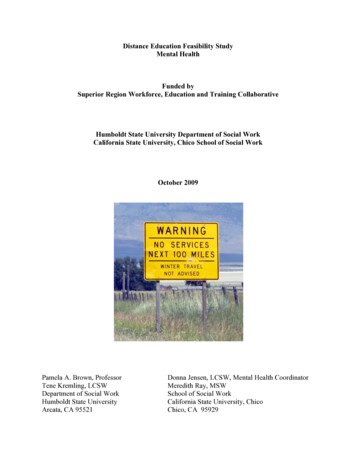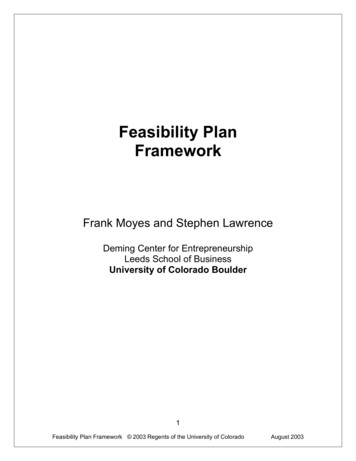
Transcription
Feasibility PlanFrameworkFrank Moyes and Stephen LawrenceDeming Center for EntrepreneurshipLeeds School of BusinessUniversity of Colorado Boulder1Feasibility Plan Framework 2003 Regents of the University of ColoradoAugust 2003
Feasibility PlanFrameworkIntroductionA feasibility plan asks two questions of a potential venture Will anyone buy the product or service? Can it make a profit?While the questions are straightforward, the answers are anything but. These twosimple questions quickly lead you to a raft of others that you will address in thefollowing sections: Opportunity or need Product/Service description Target market Unique benefits Competitive analysis Sustainable competitive advantage? Risks Profitability, break-even and investment required Conclusions RecommendationsFor high-tech ventures there is a third question that needs to be addressed - willthe product/service actually work as designed. Determining the technicalfeasibility is not within the direct scope of this Feasibility Plan.Venture DescriptionProvide a brief description of the business. What products or services are beingoffered? Where is it located? You should not assume that the reader is familiarwith your product/service, so be sure to explain and describe it carefully.Opportunity/Need1. Describe the market opportunity. What trends are favorable to the venture? Isthe market growing?2. Estimate the market potential ( , customers, units, transactions, etc.).3. Describe the market structure. Is it fragmented or dominated by largeplayers? What channels exist and are they accessible? Are there barriers toentry? It may be useful to consider the value chain?4. Describe the compelling need for the product/service? What problem is beingsolved?2Feasibility Plan Framework 2003 Regents of the University of ColoradoAugust 2003
5. Consider the following needs when analyzing the product/service. It is notnecessary for a product /service to address all of these. Physical: food, warmth, shelter, sleep, etc. Physiological: health, cleanliness, comfort, fitness, safety, etc. Emotional: euphoria, love, prestige, stress, etc Social: ethical, honesty, power, competitiveness, integrity, friendship, etc. Intellectual: achievement, better decisions, artistry, etc. Economic: revenues, productivity, cost savings, maintenance, etc. Financial: ROI, DCF, payback, burn rate, etc.Product or Service1. Describe the product or service. Consider the following product attributes (Boyd, Walker and Larreche, Marketing Management 1995, Irwin Publishing)? Performance: durability, quality of materials, defect levels, tolerances,construction, dependability, functional performance (acceleration, nutrition,taste), efficiency, safety, styling, packaging, etc. Cost: purchase price, quantity discounts, operating costs, repair costs,cost of extras or options, cost of installation, trade in allowance, likelyresale value, etc. Availability: carried by local stores, credit terms, quality of serviceavailable from local dealer, delivery time, credit card, on-line transactions,etc. Social: status, image, popularity with friends, popularity with familymembers, reputation of brand, style, fashion, etc. Service: hours, warrant, guarantee, return/replacement policy, upgrades,maintenance, training, installation, repair service, spare parts, customersupport, tech support, training, product design, make to order, level ofinventory, quotation response time, lead time, quality certification,employee capabilities, etc. Environment: location, atmosphere, layout, fixtures, aesthetics, style,sound, lighting, color, etc.2. What range of product/services is being offered? What are the prices?Describe the environment (size, décor and layout, etc.). If it is a servicebusiness, what are the employee requirements (qualifications, number, dress,etc.)?3. Describe how your product is designed to meet the needs of your targetcustomer.4. What is the revenue model?5. How will the product/service be produced and delivered?3Feasibility Plan Framework 2003 Regents of the University of ColoradoAugust 2003
6. For technology products, what are the major technical milestones that mustbe achieved? What is the basis for believing that they are achievable?Target MarketMost ventures address either a consumer market or a business market. Themotivations of each are different. If the product/service is sold through adistribution channel, system integrator or OEM, consider both.Consumer market1. Characterize the target market according to the following criteria: Demographics (gender, sex, age, race, education, occupation orprofession, income, location, etc) Psychographics or life style (attitudes, beliefs, opinions, interests, values,etc.) Social status (infers certain behavior: middle class values education,family activities, etc.)2. What does the target market think about the product/services currently in themarketplace? How willing are they to change?3. What distribution is required to reach the consumer?4. How are buying decisions made? Who makes the decision? Who influencesthe decision? Are buying decisions based primarily on price, quality, service,convenience, or others? Is there repeat business?Business market1. Describe the organizations that purchase the product/service. What industryor sector, e.g. automotive, state governments, nonprofit? What size, e.g.Fortune 100, number of employees, etc.? Where located?2. What does the target market think about the product/services currently in themarketplace? How willing are they to change?3. How are buying decisions made? Are there different approval levels? Aredecisions made centrally or decentralized? At what level is the ultimateresponsibility for approving expenditures? What is the budgeting cycle? Howlong does it take from the first contact to receipt of an order?4. What criteria are used to make buying decisions: lowest price, serviceresponse, tech support, distance from supplier, global reach, ISO 9000,design capability, range of products, just-in-time, inventory levels, etc.?4Feasibility Plan Framework 2003 Regents of the University of ColoradoAugust 2003
5. What is the payment policy? Will organizations pay cash or by credit card,make a down payment, require credit, etc.? If credit terms are required, arediscounts for early payment expected, e.g. 2/10, net 30 days? What is theactual payment practice?6. Are purchases typically made directly from the supplier, through wholesalers,distributors, retailers, or other?Unique Benefits When considering the benefits of the product or service, remember thatfeatures are not the same as benefits. The fact that a bicycle is fast andred is important, but by itself, is not a benefit. The benefit is that you canwin competitions and look cool. Think about the impact on the targetmarket’s feelings (emotions) and pocketbook (financial) (Levinson,Guerrilla Marketing, 3rd edition, Houghton Miflin Co)1. What are the major benefits of the product/service? How do the benefitsaddress the needs described above? How do the product/service featuressupport these benefits?Think beyond a generic description of benefits, e.g. Best quality: do you mean appearance, durability, reliability, etc.? Good service: do you mean on-time delivery, maintenance, techsupport, etc.? Efficiency: do you mean less time, easier to use, greater output, fewerresources, etc.? Save time: to do what? It may not always be important to save time. Convenience, for what?2. How are these benefits unique? What company is the benchmark?3. Are the benefits well understood by the target market? How do the benefitsaffect the target market’s feelings or pocketbook?Competitive AdvantageYour sustainable competitive advantage is ultimately determined by how well youunderstand the market; how well do you understand the competition; yourresources and capabilities.Competitive Analysis1. Describe the major competitors to the product/service. Consider direct,indirect, substitutes and future competitors? What are their strengths andweaknesses?5Feasibility Plan Framework 2003 Regents of the University of ColoradoAugust 2003
Prepare a matrix analysis that compares your venture with the majorcompetitors. Consider the following factors for each competitor. Do not berestricted to these, as each market will have its own. Product/Service offering – breadth and depthPrice range and policyTarget marketQuality (define the type quality)Unique featuresChannels of distributionMarketing/advertising strategyMarket perception of the company (branding strategy)Strengths/WeaknessesMarket ShareLocationOperations (manufacturing and location, outsourcing, sources for services,materials)Company size (revenues, number of customers, number of employees,etc.)Financial resources (ownership, funding, investors, profitability, financialsoundness, etc.)Strategic alliancesManagement: (backgrounds and experience)Etc.2. On what basis do the major companies in the marketplace compete: service,quality, price, new product/service introductions, customer support, etc.?3. How strong is brand loyalty? How likely is the target market to switch to a newproduct/service? What are the switching costs?4. How do your competitors perceive themselves? Obtain brochures, literature,and advertisements.Sustainable Competitive Advantage1. How much control do you have over: Setting prices. How are prices established in your marketplace (majorcompetitor, industry practice, value added, etc.)? What is the bargainingstrength of customers? Costs. Can you gain an advantage through technology, process design,resource ownership or access to raw materials, low cost labor, economiesof scale (difficult for a start-up), and capacity utilization. What is thebargaining strength of suppliers?6Feasibility Plan Framework 2003 Regents of the University of ColoradoAugust 2003
Channels of distribution. What channels of distribution exist? What accessdo you have to existing channels of distribution? Can you create newones? What is the bargaining strength of channel companies?2. What barriers to entry do you face in entering your target market? Whatbarriers can you establish that would restrict entry into of competition? Intellectual property (patents, trade secrets, copyrights, trademarks) Switching costs to your target market Customer loyalty Agreements with customers, suppliers, strategic partners Control of the distribution channel Response of competition to your entry into the market Etc.3. Is your market place dominated by a few companies that control over 60% ofthe market? Unless these companies are SOT’s (slow, old and traditional),you should not consider competing directly with them.Resources and Capabilities1. What are the venture’s resources? Financial (access to capital (equity & debt), cash reserves, governmentgrants, etc.) Physical assets (plant & equipment, raw materials, location, workingcapital, etc.) Human (social, employee knowledge, experience, accumulated wisdom,labor cost and skills, etc.) Intangible (patents, trade secrets, know-how, copyrights, databases, etc.) Organizational (culture, contacts, policies, Boards of Directors & Advisors,suppliers, service providers, etc.)2. What are the venture’s capabilities? World class management (serial entrepreneur) Well developed, high-quality, accessible contacts that take years to build Sales and marketing experience Science or technology expertise Supply chain expertise Product/service design Sales & distribution organization Total operational approach (e.g. Dell, Wal-Mart) Supply chain management Etc.Risks7Feasibility Plan Framework 2003 Regents of the University of ColoradoAugust 2003
Focus on the major risks faced by your venture. All businesses face genericrisks such as convincing customers to buy, hiring the right people, or gettingfunding, etc. What events, if they occurred, would be fatal to your business?Equally important to what can go wrong, is what must go right for you tosucceed? Consider some of the following: Marketing: Size of market, price targets, sales cycle Technological: doesn’t work, time and cost to develop, patentability Financial: exchange rate, interest rates Governmental: regulations; new law must be passed Competitive: competitor’s response to your entry, potential competition Strategic: establishing strategic partnerships Operational: cost objectives, large number of interrelated components,scalability, prime locationFinancial ProjectionsUse the Feasibility Plan Financial Projection Worksheet to prepare:Operating IncomeRevenuesCost of RevenuesGross Profit% Gross ProfitOperating ExpensesSales & MarketingDevelopmentGeneral & AdministrativeTotalOperating IncomeYear 1 1,000,000500,000500,00050%Year 2 3,000,0001,200,0001,800,00060%Year 3 00800,000( 300,000)750,0001,000,000250,0002,000,000( 200,000)1,500,0002,500,000600,0004,600,000 1,400,000Break-even Revenue 1,200,000 3,500,000 7,500,000 100,000100,000500,00050,000 750,000 500,000300,00000 800,000 1,500,0001,000,00000 2,500,000Investment RequiredCapital ExpendituresWorking CapitalOther Major ExpensesNon-recurringTotalKey AssumptionsDescribe the 3-5 key financial assumptions, e.g. revenue, margins,operating expenses, investment required, etc.8Feasibility Plan Framework 2003 Regents of the University of ColoradoAugust 2003
ProfitabilityProject a simple Operating Income Statement. Your focus should be on whatyour business might look like in 2-3 years, once the company has passedthrough the start-up phase. Can this venture be profitable? How muchinvestment is required?1. RevenuesTo project the total revenues of your product/service: Estimate the likely sales volume in number of customers, pieces, ortransactions, etc. Show your assumptions. Determine the price of your product/service. What is your pricing strategy?Consider how prices are determined in your marketplace (ma
Competitive analysis Sustainable competitive advantage? Risks Profitability, break-even and investment required Conclusions Recommendations For high-tech ventures there is a third question that needs to be addressed - will the product/service actually work as designed. Determining the technical feasibility is not within the direct scope of this Feasibility Plan. Venture .
